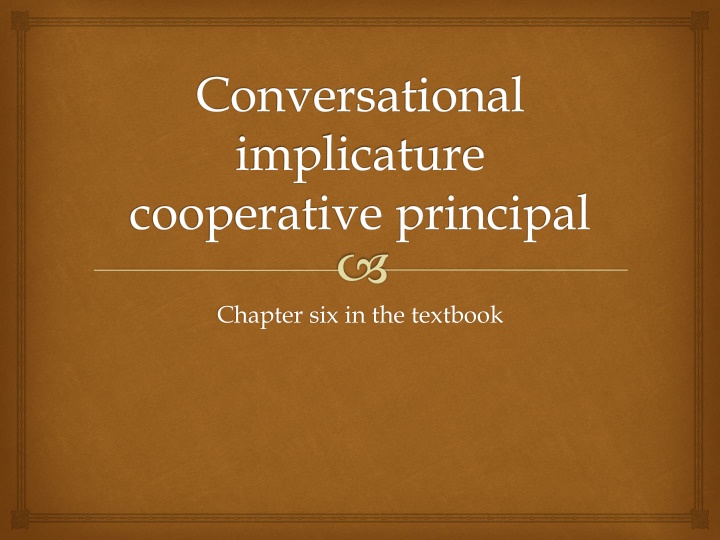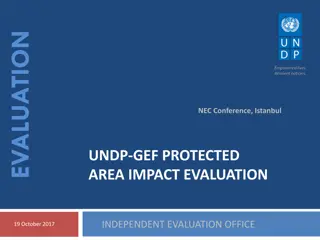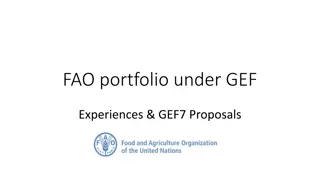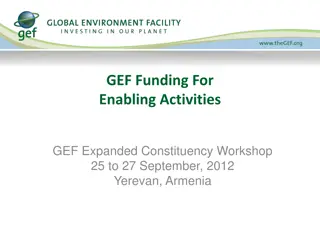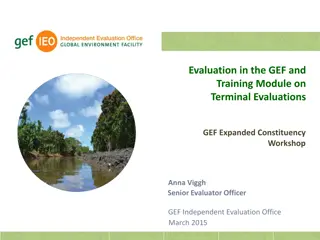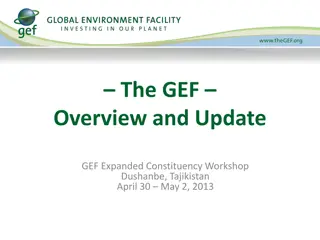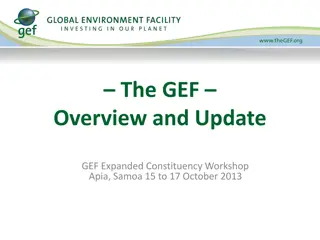Introduction to GEF Trustee Training
This content provides an overview of the GEF Trustee training covering topics such as GEF governance structure, roles and responsibilities of the trustee, funds flow, financial procedures agreements, and reporting requirements.
Download Presentation

Please find below an Image/Link to download the presentation.
The content on the website is provided AS IS for your information and personal use only. It may not be sold, licensed, or shared on other websites without obtaining consent from the author.If you encounter any issues during the download, it is possible that the publisher has removed the file from their server.
You are allowed to download the files provided on this website for personal or commercial use, subject to the condition that they are used lawfully. All files are the property of their respective owners.
The content on the website is provided AS IS for your information and personal use only. It may not be sold, licensed, or shared on other websites without obtaining consent from the author.
E N D
Presentation Transcript
Conversational implicature cooperative principal Chapter six in the textbook
The items of the lecture 1. implicature 2. conversational implicatue 3. the cooperative principle
What is an implicature? An speaker an utterance, even though it is not literally expressed. Implicatures can aid in communicating more efficiently than by explicitly saying everything we want to communicate.[ is something implies the with implicature suggests or
This phenomenon is part of pragmatics, a subdiscipline of linguistics. The philosopher H. P. Grice coined the term in 1975. Grice distinguished conversational implicatures, which arise because speakers are expected to respect general rules of conversation, and conventional ones, which are tied to certain words such as "but" or "therefore".[2]Take for example the following exchange:
A (to passer by): I am out of gas. B: There is a gas station 'round the corner B: But unfortunately it's closed today Here, B does not say, but conversationally implicates, that the gas station is open, because otherwise his utterance would not be relevant in the context.[.
Conversational implicatures are classically seen as contrasting with entailments: They are not necessary or logical consequences of what is said, but are defeasible (cancellable).[5][6]So, B could continue without contradiction: B: But unfortunately it's closed today
Grice was primarily concerned with conversational implicatures. Like all implicatures, these are part of what is communicated. In other words, conclusions the addressee draws from an utterance although they were not actively conveyed by the communicator are never implicatures.
According to Grice, conversational implicatures arise because communicating expected by their addressees to obey the maxims of conversation and the overarching cooperative principle, which basically states that people are expected to communicate in a cooperative, helpful way people are
GRICEAN MAXIMS AND THE COOPERATIVE PRINCIPLE What are we trying to do when we have a conversation with someone? There probably isn t any one thing that we re always trying to do, but often part of what we re trying to do is exchange information.
Some of the things we communicate are not part of the logical or literal meaning of our words. For example, consider the following exchange (adapted from Grice 1975): A: How does your friend like working at the bank? B: Oh, pretty well. They like their colleagues, and they haven t been sent to prison yet.
What does B mean by saying their friend hasn t been sent to prison yet? They could mean a number of things: maybe B is given to telling jokes, or maybe they mean that their friend isn t usually trustworthy, or maybe they mean that if you didn t like working at a bank you d steal money.
The actual meaning conveyed will depend on the context: what A and B both know, their relationship to one another and to B s friend, and other factors. Whatever B means, though, it s clear that by saying they haven t been sent to prison yet , B is conveying something more than just the literal meaning of their words! Many many people haven t been to prison! Why is B bringing it up?
The meaning conveyed by a utterance based on these kinds of considerations is its conversational implicature: implicatures that arise from the structure of discourse or conversation, based on our understanding of how communication works.
Conversational implicatures arise in the context of a general Cooperative Principle for communication. The idea of this principle is that we assume, when we speak to people, that we are working towards a common goal (or common goals), and we can interpret what people say in light of that.
Conversational implicatures (i) are implied by the speaker in making an utterance; (ii) are part of the content of the utterance, but (iii) do not contribute to direct (or explicit) utterance content; and (iv) are not encoded by the linguistic meaning of what has been uttered
In conversation analysis, the cooperative principle is the assumption that participants in a conversation normally attempt to be informative, truthful, relevant, and clear
The cooperative principle Make your contribution such as is required, at the stage at which it occurs, by the accepted purpose or direction of the talk exchange in which you are engaged.
The maxims of conversation The maxim of Quality try to make your contribution one that is true, specifically: (i) do not say what you believe to be false (ii) do not say that for which you lack adequate evidence The maxim of Quantity (i) make your contribution as informative as is required for the current purposes of the exchange (ii) do not make your contribution more informative than is required
The maxim of Relation (or Relevance) make your contributions relevant The maxim of Manner be perspicuous, and specifically: (i) avoid obscurity (ii) avoid ambiguity (iii) be brief (avoid unnecessary prolixity) (iv) be orderly
The maxim of quantity states: Make your contribution as informative as is required. Do not make your contribution more informative than is required. To follow this maxim, we make the strongest claim that s both compatible with the facts and relevant in context.
For example, consider the following conversation: A: Does Elspeth have any siblings? B: Yes, she has a sister.
When hearing B s response, A assumes that B is fully answering the question that is, that B is being as informative as possible. So A would naturally assume that Elspeth has exactly one sister, and doesn t have any brothers. If it turned out that Elspeth has two sisters and a brother, A would feel that B had misled them this would be an example of violating the maxim of quantity.
The maxim of quality states: Do not say what you believe to be false. Do not say that for which you lack adequate evidence. In some ways the first of these points is the most basic maxim for the Cooperative Principle: communicating in good faith seems to require that we are or at least try to be truthful.
Violating the maxim of quality involves lying intentionally saying things that are untrue or else saying things that you don t have enough evidence for.
If your housemate asks you what day garbage is being collected this week, and you can t really remember but you think it might be Tuesday or Wednesday, you would be violating the maxim of quality if you confidently replied: Garbage pickup is definitely Wednesday this week.
Flouting the maxim of quality usually involves irony or sarcasm. For example, consider the following mini- dialogue between a child on a road-trip and their parent: Child, asking for the 20th time: Are we there yet? Parent, fed up with answering: Nope, we re just going to keep driving in this car for the rest of our lives.
In this case the parent doesn t intend their child to take their words literally; they re flouting the maxim of quality to convey an implicature that the question was unwelcome. Metaphors or idioms are also cases of flouting the maxim of quality! If I say a scarf is as light as a feather, this is not literally true but I don t intend for it to be taken as true!
The maxim of relevance states: Be relevant. The idea behind this maxim is that when we converse, we shouldn t introduce irrelevant topics we try to stick to the topic of conversation, and we assume that our contributions will be interpreted in that light.
Consider the following exchange: A: Are you visiting family this weekend? B: I have a term paper due on Monday.
A natural interpretation of this exchange is that B is saying that they do not plan to visit family this weekend, and that the reason is that they have to work instead.
But this interpretation is an implicature, because if we think only about the literal meaning of B s words, this interpretation is a bit mysterious B doesn t actually directly answer A s question, but introduces new topic that doesn t have anything to do with travel or families.
If we assume that B intends to be relevant, though, we can explain the implicature: for the term paper to be relevant to the question about travel, it must be that working on the paper controls whether B is able to travel to visit family.
If we violate a maxim, then we simply fail to follow it. At best, violating a maxim results in being uncooperative conversationalist. At worst, violating a maxim involves lying or being intentionally misleading. a confusing or
Flouting the maxim of relevance involves saying obviously irrelevant, communicate that you want to change the topic of conversation. something often to
For example, if a conversation starts getting awkward and you interject by saying: How about that hockey game last night? (when nobody had been talking about sports, never mind about hockey), then you would be flouting the maxim of relevance in the hopes that your audience would understand that you were trying to convey: Can we please talk about something, anything, else?
The maxim of manner states: Avoid obscurity of expression. (That is, don t use words or phrases that are hard to understand.) Avoid ambiguity. Be brief. Be orderly.
Avoid obscurity of expression To follow this maxim, we try to use words and expressions that our audience understands. For example, the terminology you would use when explaining a topic in a university class is different from the terminology you d use if talking about the same thing to a Grade 1 class!
Violating this sub-maxim involves using words and phrases your audience doesn t know. We often do this accidentally for example, your linguistics professor might accidentally use a grammatical term that they haven t defined in class but if you use a word that you suspect your audience will misinterpret, with the goal of misleading your audience, that would also be a violation of this sub-maxim.
Flouting this sub-maxim would involve intentionally using words that you don t expect your audience to understand in most contexts, this would be with the goal of conveying something like: I m smarter / know more than you pretentious and rude. do , which is
Avoid ambiguity To follow this sub-maxim, we try to avoid saying things that can reasonably be interpreted in more than one way. It s very easy to violate this sub-maxim accidentally, because often you don t see the ambiguity in something you say until it s pointed out to you! But again, you can be intentionally ambiguous in the hopes of misleading people this is an uncooperative way of talking. .
Flouting this sub-maxim often happens in certain kinds of jokes, as in the following: A man walks into a bar. Ouch! This joke turns on two things: 1. being familiar with the common joke set up: Someone walks into a bar. and 2. intentionally using the other meaning of the ambiguous word bar
Be brief To follow this sub-maxim, we avoid going on at great length when a shorter statement would do. Violating this sub-maxim involves saying or writing something much longer than is needed. Flouting this maxim is more subtle. One example is avoiding a single word and instead using a long paraphrase, as in: What did you have for dinner last night? Well, we combined all the ingredients listed in a recipe for risotto milanese, in the indicated order, and the result was edible. By using this long paraphrase, instead of saying We made risotto milanese. , the second speaker s response gives rise to the implicature that the recipe didn t turn out as intended, or wasn t very good.
Be orderly To follow this sub-maxim, we list or relate things in an order that makes sense. For example, when telling a story, we usually start at the beginning and then relate events in the order they happened in. Violating this sub-maxim can be very confusing, as you ll know if you ve ever had to interrupt someone for clarification about the order of events in a story they re telling! Flouting this sub-maxim is not something we would do very often. A possible example might be intentionally relating events out of order when writing a fictional story, to convey something about the mood or the narrator s state of mind.
